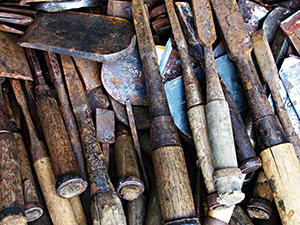7 Ways to Reduce Tool Wear
Posted by
Mike Williams on Thu, Sep 05, 2013
 CNC machine cutting tools are perishable by nature, but that doesn’t mean you can’t take steps to prolong the life of your cutting tools. Not only are the tools, themselves, an expense but replacing worn tools can interrupt production and add labor costs. Not replacing worn tools in a timely manner can also impact the quality of a workpiece.
CNC machine cutting tools are perishable by nature, but that doesn’t mean you can’t take steps to prolong the life of your cutting tools. Not only are the tools, themselves, an expense but replacing worn tools can interrupt production and add labor costs. Not replacing worn tools in a timely manner can also impact the quality of a workpiece.
Here are 7 ways you can get the most out of your cutting tools.
- Recognize the signs: When tools become worn or damaged they typically require greater cutting force and may generate increased temperatures in the tool and the workpiece. Surface finish may suffer as well as dimensional accuracy. Worn tools are also subject to breakage, thus interrupting a machining cycle.
- Understand the kinds of tool wear: Flank wear is simply the result of the pressure of the cutting tool on the workpiece. Notching is damage caused by adhesion to the rake face and flank of the tool. Cratering of the rake side of the insert occurs from a chemical reaction between the material and cutting tool. Edge build-up typically happens when cutting softer materials such as copper and aluminum. These materials can adhere themselves to the cutting tool surface. Drill bits are subject to edge wear and inserts can experience edge cracks.
- Be aware of the effects of temperature: The energy used in cutting metals converts to heat. About 80% of this heat is typically transferred to the chips, which leaves 20% affecting the tool and spindle. These temperatures can be as high as 700º F and can deform both the cutting tool and the workpiece.
- Apply appropriate coolant: It’s critical to control the affects of temperature on tooling. When temperatures exceed 500º F molecular changes begin to take place even in hardened steel. The nature of the material you are cutting, the spindle speed, feed-rate, complexity of cut and operations to be performed will all impact the way coolant should be applied during a machining cycle. Coolant delivery should be programmed to apply the proper pressure at various stages of an operation, either through the CNC machine controller or via a peripheral programmable variable pressure coolant system.
- Consider the workpiece material: All metals have unique characteristics. Some are relatively easy to machine while exotic alloys, titanium and other hard-to-cut materials are more challenging. Machining unleaded brass, for example, requires a different approach than cutting leaded brass. Unlike 360 brass that requires simple cutting tools, unleaded brass is not only harder to machine but creates more heat, thus requiring different coatings, higher helix angles, increased clearance angles and wider flutes.
- Match the right tool to the job: Gosiger 3-D Application Engineer Brian Stall points out, ”The tooling is critical, including having the right geometry, hardness, coating and sharpness. On many hard metals, for example, if the tool is too sharp it will wear prematurely.” Gosiger partner Sandvik Coromant offers a comprehensive guide to cutting tool types and their applications on their website.
- There’s also an APP for that. Sandvik offers a smart phone APP (The Sandvik Coromant app for turning multi-materials) that matches your application to the appropriate insert. You can download the free APP at the iTunes Store or at Google Play.
More questions? Contact the Gosiger team for advice based on over 90 years of machine tool experience.
 |